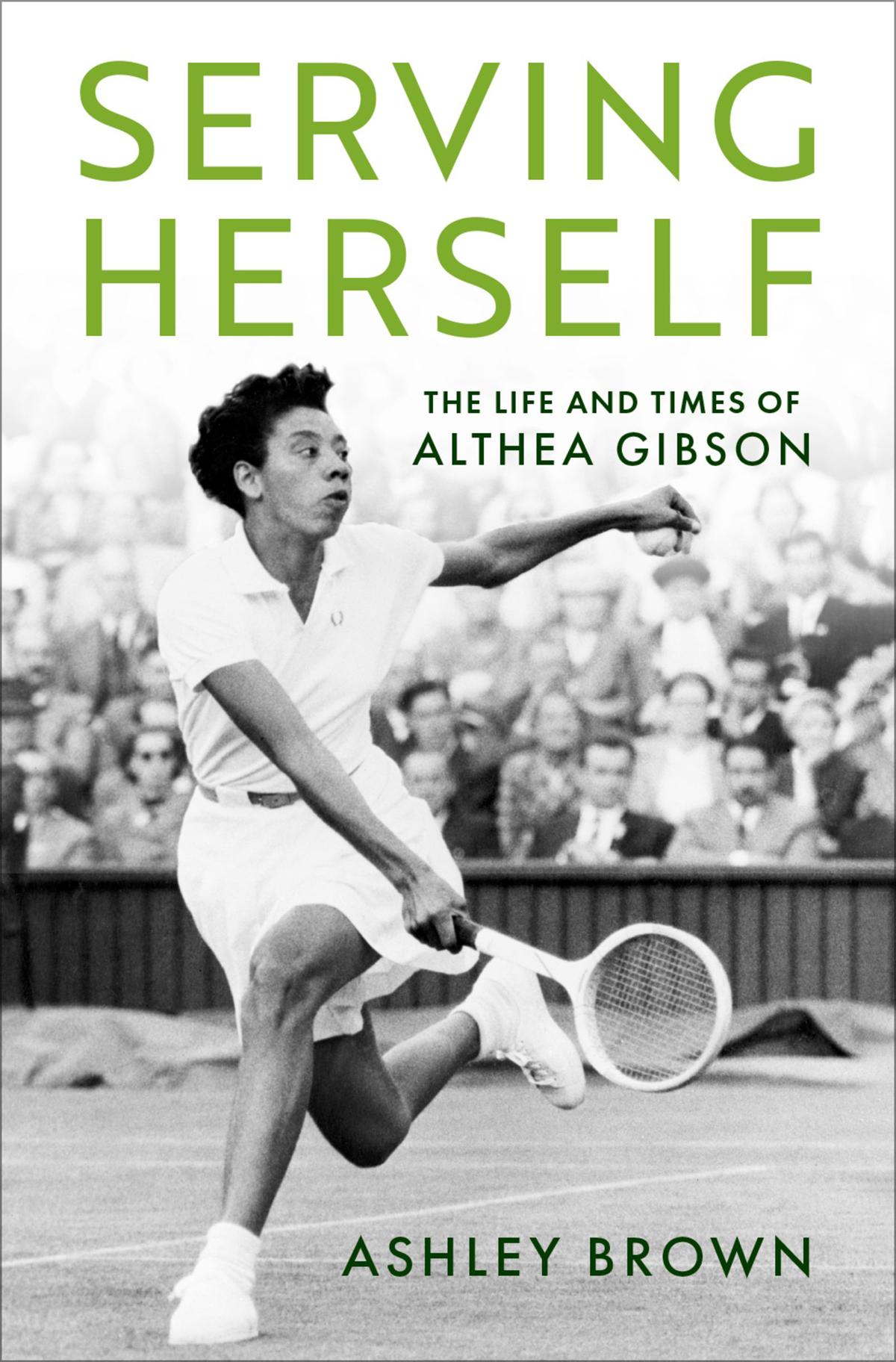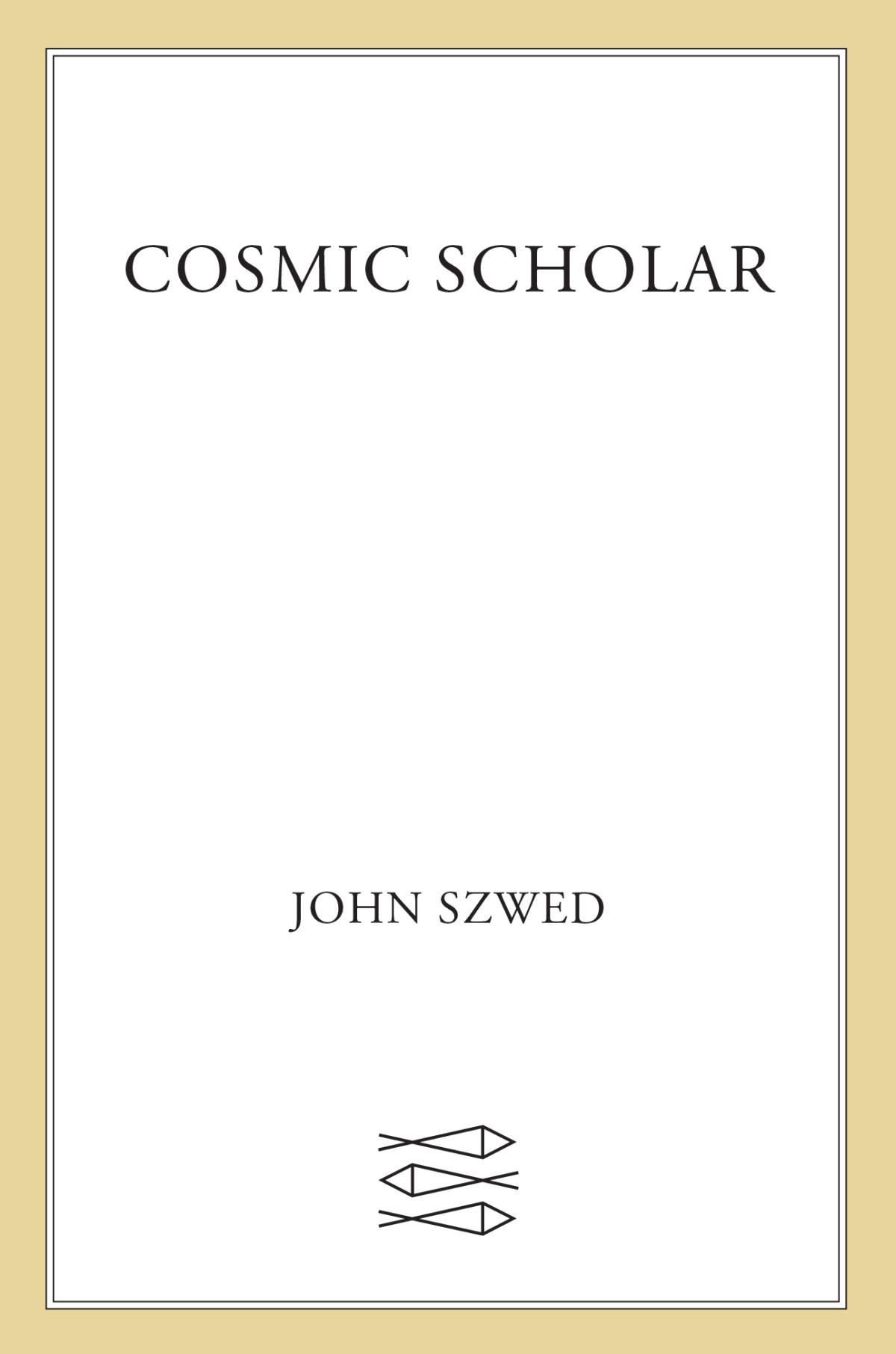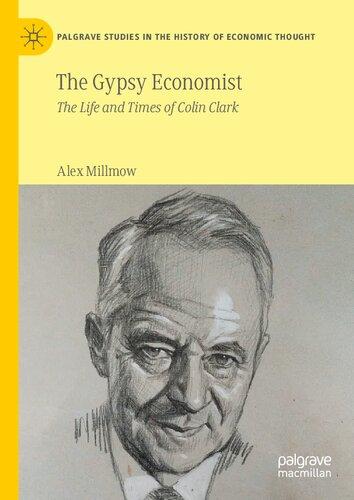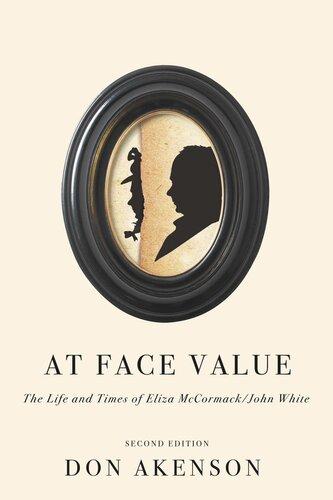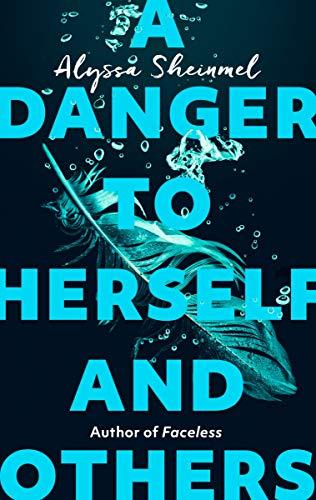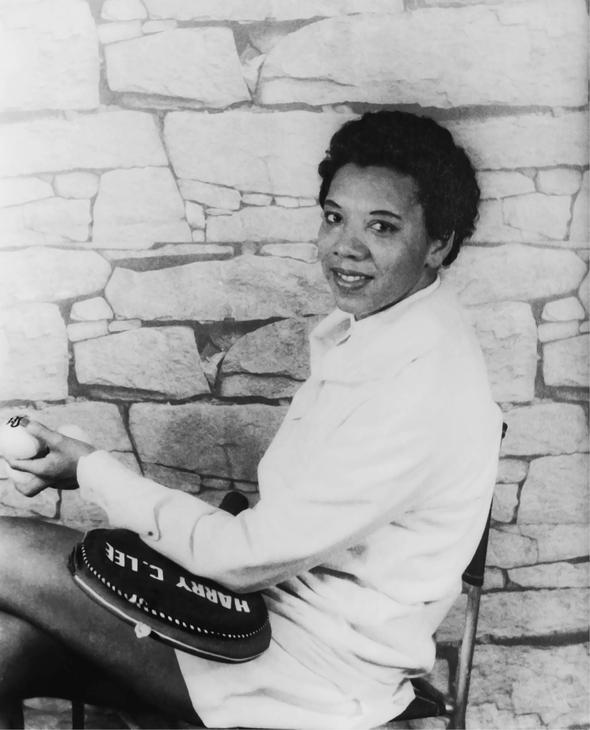Acknowledgments
THE CLICHÉ IS true: it isn’t how you start that’s important, it’s how you finish. Serving Herself: The Life and Times of Althea Gibson began as my doctoral dissertation and represents more than a decade of research and writing. In that time, many people and institutions contributed to the completion of this book. I offer my heartfelt thanks to them here.
I could not have asked for a better editor for my first book than Susan Ferber. Susan saw the strengths and possibilities of this biography at the right time and consistently gave me the time, space, support, and trust that I needed. She is everything—scout, coach, analyst, cheerleader, teammate, talent manager, problem solver, and visionary. She is also a very fine person. Susan has been a dream to work with, and publishing with Oxford University Press has been a dream come true. Assembling the final product would not have happened without the careful diligence of copy editor Sue Warga, indexer Colleen Dunham, proofreader Bob Land, and production editor Amy Whitmer.
The University of Wisconsin–Madison has been my ideal professional home since 2017. The History Department is an all-star team. Whether an assistant, associate, or full professor, every member of the faculty has contributed to my growth here. My Madison story begins with the dedicated members of the search committee that brought me to campus in February 2017: Sue Lederer, Tony Michels, Karl Shoemaker, and co-chairs Susan Lee Johnson and David McDonald, both of whom became my mentors. Susan (now of the University of Nevada–Las Vegas) opens doors and creatively paves paths. David is an astute reader and a terrific conversationalist, especially about the world and history of golf. In subsequent years, other colleagues stepped forward to further
support my work. Brenda Gayle Plummer is a trailblazer whose encouragement has meant a great deal to me. Lee Palmer Wandel is a keen listener whose clear-sightedness has positively impacted my approach to pedagogy. Leonora Neville stands out as an advocate and a creative leader. As I entered the final stages of this project, Mary Louise Roberts became my mentor and friend. Lou’s attention to detail, wit, wisdom, and commitment to excellence have enhanced my work.
Allan H. (Bud) Selig plays an important role in my work. In 2010, Commissioner Selig, a UW-Madison alumnus, made a major gift to the History Department to create the Allan H. Selig Chair in the History of Sport and Society, the position that I have held since January 2020. The chair, a rarity at an American university, enables me to do what I love: encourage my students to think about the people, places, productions, institutions, and reach of American sports in new and expansive ways. My students teach me, and they apply their knowledge and skills to innovate their chosen fields. I draw much energy and inspiration from their examples. Teaching the course Biography in U.S. Sport History in the fall of 2021 was especially helpful as I completed the final chapters of the manuscript. The Selig Faculty Fellowship in Sport History, awarded during the 2017–2018 academic year, gave me the time and resources required to write, among other things, “ ‘Uncomplimentary Things’: Tennis Player Althea Gibson, Sexism, Homophobia, and AntiQueerness in the Black Media,” which the Journal of African American History published in 2021. The research support of the Selig Chair has been invaluable to bringing ServingHerselfto fruition and thus familiarizing historians, students, and others with Althea Gibson’s preeminent place in the history of sports. Commissioner Selig’s generosity and leadership are signal reminders of the need for and vast impact of philanthropy in higher education.
Institutional support has been essential to ServingHerself. George Washington University backed my studies and research through its Presidential Merit Fellowship, the Jeffrey C. Kasch/GWU Horton-Vlach Fund for American Studies Research Fellowship, and multiple American Studies Academic Excellence Awards for Summer
Research. The North American Society for Sport History’s 2015 Graduate Student Essay Prize, which led to the publication of my first article, “Swinging for the State Department: American Women Tennis Players in Diplomatic Goodwill Tours, 1941–1959,” in the JournalofSportHistory, helped establish my reputation as a scholar. Giving the graduate student keynote address at the 2015 NASSH conference in Miami was an experience that I will savor for the rest of my career. The opportunity gave me a view of what the future might bring. The Alumnae Association of Mount Holyoke College’s 1905 Fellowship funded an important research trip to Tallahassee, Florida, in 2017. An associateship at the Five College Women’s Studies Research Center, led by Banu Subramanium, was a pivotal launchpad for my transition from graduate school to the professoriate. That same year, Lucas Wilson, Preston Smith, Lynda J. Morgan, and the Africana Studies Department at Mount Holyoke gave me a bridge that added to my appreciation for my alma mater. In 2017–2018, a postdoctoral fellowship at Emory University’s James Weldon Johnson Institute for the Study of Race and Difference, led by Andra Gillespie, became an essential landmark on my professional journey. The University of Wisconsin–Madison has buttressed my endeavors through the Selig Chair, support from the Office of the Vice Chancellor for Research and Graduate Education, and, in 2020–2021, an invaluable Nellie McKay Research Fellowship. Accessing resources at UW-Madison would not have been possible without the diligent efforts and knowledge of Todd Anderson, Sophie Olson, and Jana Valeo. Leslie Abadie, Scott Burkhardt, Mike Burmeister, Lisa Normand, John Persike, and Jenny Schumacher make everything better. The support of the organizations and people named here supplied much-needed time to work, access to the many sources required to write this book, and additional authorial motivation. Along these lines, I extend my thanks to the many colleagues who have shared encouraging words, insights, and, in some cases, invitations to share my work with their campus communities. Leaders in this respect are the late Craig Lanier Allen, Amy Bass, Madeleine Blais, Andy Bruno, Aram Goudsouzian, Pamela Grundy, Eric Allen Hall, Felipe Hinojosa, Tera W. Hunter, Jane Kamensky, Rita
Liberti, Mary G. McDonald, Michele Mitchell, Elizabeth Odders-White, Martin Polley, Randy Roberts, Jaime Schultz, Johnny Smith, Susan Ware, Brandon Winford, Darius Young, and Oxford University Press’s anonymous reviewers. The author of groundbreaking works, Susan K. Cahn is a major reason this book exists. I have been influenced by Susan’s scholarship, encouraged and enriched by her interest in my research, and strengthened by her reminder that we must care for ourselves as people rather than exclusively as producers of scholarship.
My first intellectual homes were in Massachusetts and Washington, D.C. When I was an undergraduate at Mount Holyoke College, David Sanford, Preston Smith, Paul Staiti, and Elizabeth Young sparked my dream of becoming a professor. At George Washington University, Kip Kosek, Erin Chapman, Suleiman Osman, Melani McAlister, Jennifer Nash, and Tom Guglielmo helped make that dream come true. During a chance meeting at GW’s Gelman Library in 2014, the late Jim Miller said the right thing at the right time.
Sources are the lifeblood of scholarship. I appreciate the efforts of the staff at each of the institutions whose archives I accessed. I give special praise to Meredith Miller Richards, Nicole Markham, Ymelda Rivera Laxton, Troy Gowen, and Doug Stark of the International Tennis Hall of Fame and Museum; Rebecca Baugnon and Gerald Parnell at the University of North Carolina–Wilmington; Gloria Woody at Florida Agricultural and Mechanical University’s Coleman Library; E. Murrell Dawson of the Meek-Eaton Black Archives Research Center and Museum; Beatrice Hunt and the archives of the West Side Tennis Club; Toni Wiley and Sportsmen’s Tennis and Enrichment Center; and the employees of the Library of Congress and the National Archives and Records Administration in College Park, Maryland. This project would have suffered immeasurably without the consistent support of Carolyn Eaton, the youngest daughter of Dr. Hubert A. and Celeste Eaton. Not only did Carolyn grant me permission to access her father’s papers in 2013, but she also offered terrific and timely advice that Althea Gibson would have liked: “Just do you.” Like her parents, Carolyn is a champion of integrity and African American history. The Eaton family has my
respect and my gratitude. Michelle Curry, executor of the Gibson estate, is an important figure in sharing Gibson’s legacy. Don Felder, Gibson’s second cousin, came through in a big way by sharing original sources to which I had sought access for years. Don and Michelle’s joint efforts in many forums are teaching people across the country and around the world about Gibson.
In any life and career, time, interests, geography, and fate intervene in such a way that we get to know some colleagues better than others. The COVID-19 pandemic brought welcome opportunities to forge new bonds and strengthen old ones. I could fill a book with memories of Jennifer Ratner-Rosenhagen’s many gestures of goodwill before and during the pandemic. Jennifer is a friend, muse, guide, and sounding board with a generous spirit. My experience of this unprecedented time in history would have been very different without the kindnesses of Jennifer and her family, especially Ulrich, Miriam, and Mabel. Nan Enstad has been equally munificent. Time with Nan allowed me to laugh and relax. Nan and her partner, Finn, embody living and working with honesty. Emily Callaci, my running buddy in the pre-Prefontaine sense of the word, is a model of benevolence and persistence. Sharing in the childhoods of Emily’s sons, Theo and Otis, has delighted me beyond words. .
The past dozen years brought opportunities to reflect on the meaning of friendship. Friends are there for you with positivity and generosity when things go well, not just when things go wrong. Friends enhance the afterglow of your victories, great and small, and the things that give you joy. Lila Webb’s frankness, wit, confidence, and laughter have enriched my life for more than twenty years. Her children, Rowan and Juna, have grown up alongside this book. Catherine Connor’s optimism is contagious. Cathy and my grandfather have convinced me that cheerfulness is essential to becoming a nonagenarian. Sally Sheaffer Lehman’s company and her belief in me have never wavered. Discussions with Doc Pye led me to make the leap to graduate school. Doc was the first to believe in
this project. My journey would have been much more difficult without her. Whenever I shared good news about some breakthrough or honor, Doc always said, “I am happy for you, and I am not surprised.” Mickey Goldmill has been a consistent source of fun, clarity, challenge, patience, and strength. Wherever I have been, Mickey has been there, too. Wherever I go, she will be there, too.
My family is ever-present in my life. I thank my grandfather Willie James for telling me when I was four years old that I should go to college. My brother, Dudley, influenced my early interest in sports. My aunt and uncle, Michelle and Craig, showed me that tennis and golf are magical games. I thank my parents, Richard and Iva, for accepting my wish to pursue my dreams wherever they lead me. More than anyone else, Mom and Dad remind me of the importance of being ambitious and true to myself, maintaining discipline and focus, persevering, having faith, and deriving pleasure from work.
Ruby, my dear niece and daughter of Dudley and Rochelle, my very kind sister-in-law, is the pride and joy of our family. I sincerely hope Ruby and her generation will read works of history and learn— by thinking deeply about the successes, shortcomings, failures, and unrealized ambitions of our predecessors—how to make lives of happiness, purpose, productivity, and fulfillment. May they also find the ingredients for making a compassionate country and a peaceful world.
Introduction
ALTHEA GIBSON SHOULD have been on top of the world in the summer of 1957. Instead, she found herself at odds with it yet again. In July, Gibson won the women’s singles title at Wimbledon, six years after becoming its first Black American competitor. Queen Elizabeth II presented her with the victor’s plate, marking the first time a Black person, male or female, had claimed the top prize in tennis. Gibson was the belle of the Wimbledon Ball that night, dancing the traditional first dance with Lew Hoad, the men’s singles champion from Australia. Blond and White, Hoad guided her around the dance floor. Some attendees watched in admiration; others stared with displeasure.1
Days later, Gibson was back in her hometown, New York, riding up Broadway in an open convertible and waving at the thousands of people who lined the streets during the ticker-tape parade held in her honor. The mayor gave her the key to the city, and a series of speakers lavished her with praise during a banquet at the WaldorfAstoria Hotel. Gibson was a “wonderful ambassador and saleswoman for America,” said one, a reference to the dozens of tournaments she had won around the world. She “came up the hard way and now stands at the top of her class,” remarked another.2
The mood changed in Chicago, where Gibson went to compete in the U.S. Clay Court Championship the following week. Because she was Black, none of the hotels in River Forest, the leafy suburb that hosted the tournament, would give her a room, forcing her to find lodging miles away. Intent on maintaining her form through the end of the season, she prioritized practice and rest over media obligations before the tournament began. Reports emerged that
Gibson gave “brush-offs” to the mostly male press corps, refusing requests for interviews and photographs. Some journalists got close enough to ask Gibson questions. With the civil rights movement under way, they wanted to talk about race. Did she think that her accomplishments in tennis “helped” other African Americans? Did she “cherish” being compared with Jackie Robinson, who ten years earlier had become the first Black man to play in baseball’s major leagues in the twentieth century?3 “No, I don’t consider myself to be a representative of my people. I am thinking of me and nobody else,” she reportedly answered.4 “I’m trying to help myself.”5 Gibson won the tournament decisively, but her image was tarnished as writers called her “arrogant,” “non-cooperative,” and “as ungracious as a stubborn jackass.”6
Apologies and appeals for understanding were not Gibson’s style; doubling down and going on the offensive were. Speaking outside Pittsburgh in early August, she gave her version of what had happened in Chicago: “They said I was hostile and wouldn’t cooperate. I say I wasn’t given a fair opportunity to be helpful.” She had no plans to be helpful going forward. “Frankly, I’m tired of being pushed around by people who don’t seem to have any concern for my feelings,” she told the press pool, living up to the derisive labels —“Jackie Robinson without charm” and “Ted Williams without his skills”—that some sportswriters had given her.7 “I’m ready to start speaking out and saying what I think is right. I might lose some friends, but there are those who will understand my viewpoint. . . . [F]rom now on I’m going to do what I think is right and not worry about what some people who don’t mean anything to me say. Then when I get mad, I’m going out on the tennis court and [will] take it out on whoever’s across the net.”8
Gibson soon made good on her promises. The subject of Time’s cover story for the last week of August, she spoke candidly about her fraught relationship with the notion that she carried a special duty to be a racial representative or spokesperson as the only African American in elite amateur tennis. “I tried to feel responsibilities to Negroes, but that was a burden on my shoulders,”
she admitted. “If I did this or that, would they like it? Perhaps it contributed to my troubles in tennis. Now I’m playing tennis to please me, not them.”9
Two weeks later in September, Gibson won the United States National Lawn Tennis Championship at Forest Hills (now the U.S. Open), where she had been the first Black player allowed to enter in 1950. Vice President Richard Nixon presented her with the trophy. When asked which victory that summer was more meaningful, she replied, “Winning Wimbledon was wonderful, and it meant a lot to me. But there is nothing quite like winning the championship of your own country. That’s what counts the most with anybody.”10
The victory meant that Gibson had achieved another historic racial first. She would accomplish still more. She successfully defended both her Wimbledon and U.S. Nationals titles in 1958, giving her, with her capture of the French Championship in 1956, a career total of five Grand Slam singles titles, joining her six others in doubles and mixed doubles. In 1963, she was the first African American to compete on the Ladies Professional Golf Association (LPGA) Tour. In 1971, she was the first African American inducted into the International Tennis Hall of Fame. Between 1975 and 1977, she was the athletic commissioner for the state of New Jersey, the first woman and the first African American to hold that position. Every opportunity, every setback, every accolade, and every criticism that Gibson received was linked to her identity as an African American woman who dared to defy social norms and expectations of what tennis players, golfers, race leaders and pioneers, and even Black women said and did and how they looked. She persevered in the face of it all as her audacity and achievements challenged the progressiveness of the communities and institutions that she entered and occupied.
Serving Herself explores the history of sports integration by taking readers on a journey with Althea Gibson, the preeminent African American female athlete of the mid-twentieth century, through her
rise, falls, triumphs, and repeated comebacks. No apologist, Gibson fought valiantly for control over her life, career, image, and future at a time when women were expected to be passive. A restless and insatiable competitor, she was determined to win, and she put in the work and made the sacrifices to do it. A fiery competitor with little regard for social graces, she cared more about winning games and matches than winning friends and fans. Gibson was a world champion who was all too human. In a world that placed limits on opportunities for someone of her race and her gender, she gambled, taking risks and making hard choices that paid off. Yet she also paid a high price for her decisions. She traveled the streets and the world as a woman alone. She enjoyed the perks of being an “exceptional” African American. With her talents and ambitions, she circulated among the social elite, galaxies away from her humble origins, and moved in the same orbits as some of the most acclaimed people of her era in sports, politics, and entertainment. She lived with surveillance, exploitation, being made into a spectacle, and constant criticism all because the world had never seen a woman like her. The result is a very different story about sports integration and its outcomes than the familiar narrative, one that instead is intended to reflect on what we ask of our cultural heroes and “pioneers,” whether they owe us anything at all, and what our responsibilities to them are.
Unlike most histories of sports integration, this is not a saga of men.11 Rather, it is the story of a complex, unorthodox, courageous, and vulnerable woman who navigated uncharted territory in the face of an unjust society to create a blueprint and path for herself and to become the first Black female superstar in sports. Gibson had to be her own model, revisiting techniques that she devised as the lone African American in elite amateur tennis to make it as the lone Black woman in professional golf. Those strategies included calculated silences and dissembling, approaches adopted by many other Black women who sought to make room for themselves in hostile places where their worth was doubted.12 At the same time, she was remarkably candid about her joys, frustrations, and troubles, in
hundreds of interviews and two autobiographies. Gibson’s existence requires that we recalibrate the tendency for the phrase “Black athlete” to refer exclusively to men. She reveals the underappreciated role of women in sports integration, seeing beyond traditional roles they held as wives, mothers, and status symbols.13 For Gibson, women were fellow athletes and allies who supported her cause as well as antagonists who stood in her way. Her interactions with men were just as mixed. Most of her mentors and role models were men she could depend on for advice and charity, especially as she made her way in tennis. Yet she also encountered paternalism from those who tried to make decisions for her. The battles of Gibson and her athletic peers beg women’s history to move sports away from its margins and to its center, where so many singers, dancers, actresses, writers, and other performers and cultural figures have been welcomed in recent years.14
Class and place are essential to this story. It follows Gibson in the high-toned and ultra-White settings of tennis and golf, sports with cultures, connotations, and expectations for comportment that differed dramatically from those in the worlds of baseball, football, basketball, boxing, and track and field where Black athletes traditionally found success and where most other books have trailed them, especially on American soil with American protagonists. Gibson’s life is indeed an American story: she pursued her dreams and sought to support herself with ingenuity and determination across the United States. It is also a global one, set in the Caribbean, Europe, Southeast Asia, the Middle East, Canada, Mexico, Australia, and Latin America—all places where it was often easier for her to find respect as a Black American. Yet no matter where Gibson competed, and whether it was in amateur or professional tennis or in golf, attention was always paid to whether her clothes and hair sufficiently upheld the gender and class norms of her sports and represented Black people well, aesthetic concerns and pressures not foisted upon male athletes.
Gender and sexuality are essential to this biographical history of sports integration. Masculinity, marriage, and assumed
heterosexuality have long been glossed over as important factors in the stardom of Black sportsmen.15 The scrutiny, inquisitions, and innuendoes that Gibson endured for being unmarried for most of her career in sports force us to confront the impact of sexism, heterosexism, and homophobia on sports integration. Indeed, she was subjected to sexism and racism. Her life upends the dominant story that when African Americans, whether as individuals or on teams, crossed the color line in sports, the entire race won. Gibson faced higher expectations and harsher standards, ambivalence, and even outright animosity within African American communities as she reached racially unprecedented heights in tennis ahead of Black men. That she was a woman who crossed the color line had lasting, negative implications on her life until the end. This makes for a darker, more unsettling story about sports integration than has previously been told.16
America and the world began remembering and rediscovering Gibson even before her death in 2003 at the age of seventy-six. The news in the mid-1990s that she was in poor health and had fallen on hard times, subsisting on Medicare and Social Security, led to a flurry of articles, editorials, and fundraisers. In 2001, General Mills placed a picture of Gibson on its iconic Wheaties cereal box. The year 2004 brought the publication of two biographies by journalists and a close friend. In 2012, Branch Brook Park in Newark, New Jersey, the state that she called home for the last four decades of her life, honored her with a statue near the tennis complex that carries her name. In 2013, the United States Postal Service commemorated Gibson’s career with a stamp bearing her image in its Black Heritage series. Two years later, filmmaker Rex Miller released a documentary, Althea, that has been screened around the world and featured as part of the long-running PBS series American Masters. CBS Sports has released its own documentary, ArthurandAlthea, a dual portrait of Gibson and Arthur Ashe, the first African American man to win the U.S. Open (1968), the Australian Open (1970), and Wimbledon
(1975). Biopics are in development, too. In 2022, Gibson’s first autobiography, I Always Wanted to Be Somebody (1958), was reissued, and the block of West 143rd Street on which she lived during the 1930s and the 1940s was renamed for her.17
Opening day of the 2019 U.S. Open brought a particularly grand commemoration of the trailblazer’s enduring significance. The United States Tennis Association (USTA) unveiled a statue of Gibson on the grounds of its Billie Jean King National Tennis Center in Flushing, New York. For years, the USTA had recognized Gibson primarily in brief memorials. In September 2004, star players King, John McEnroe, and Zina Garrison, journalist and commentator Bud Collins, and former New York mayor David Dinkins paid tribute to her in a program before the start of the quarterfinals match between Jennifer Capriati and Serena Williams, who, like her older sister Venus, had been inspired as a child when she learned that tennis had a Black champion in the 1950s. Future salutes at the U.S. Open coincided with the major anniversaries of Gibson’s victories there. Gibson was featured in or the central subject of several works of children’s and young adult literature during her lifetime, and still more have told sunnier versions of her story in recent years. A letter-writing campaign by a group of children contributed to the USTA’s decision to establish the permanent memorial. The statue was a priority for Katrina Adams, the association’s first Black female president and its CEO from 2015 to 2018. As a child, Adams met Gibson during a tennis clinic in Chicago in the 1970s. Adams came to view their chance encounter as a mandate: “Whatever I was going to do in my life and career as a player, it had to somehow involve the continuation of Althea’s work breaking down barriers for women and people of color.”18
Made of granite and bronze, weighing more than eighteen tons, and scaled at three and a half times life size, the “monument,” as its sculptor, Eric Goulder, refers to it, stands in front of Arthur Ashe Stadium, named in 1997.19 Goulder chose to present Gibson from the shoulders up, rising from a cube and looking as she did in August 1950, when, at the age of twenty-three, she made her
historic debut at the U.S. Nationals. While Gibson’s right shoulder remains in the cube, her left shoulder is uncovered. Alluding to Gibson’s impact on sports, Goulder explained during the unveiling ceremony, “Her shoulder is exposed because that’s the shoulder that everybody since has stood on.”20
Gibson was indeed a foundational figure in sports. Serena Williams has said that Gibson “paved the way for all women of color in sport.”21 Certainly, the Williams sisters, Garrison, Lori McNeil, Chanda Rubin, Sloane Stephens, Cori “Coco” Gauff, and every other woman of African descent in tennis are part of her legacy. So are Renee Powell, LaRee Sugg, Shasta Averyhardt, Sadena Parks, Cheyenne Woods, Ginger Howard, and Mariah Stackhouse, the small group of Black women who have played on the LPGA Tour.22 Characterized by a powerful serve and all-around speed, her style of play influenced subsequent generations of champions in women’s tennis, including Christine Truman, Darlene Hard, Maria Bueno, and Billie Jean King. Gibson, moreover, toured as a professional tennis player and tried her hand at being a promoter in the game more than a decade before the founding in 1970 of the Virginia Slims Circuit, the forerunner of the current-day Women’s Tennis Association (WTA). Gibson’s rise was integral to Arthur Ashe’s career. They shared a mentor, Dr. Robert Walter Johnson, who applied the techniques that he had crafted while preparing Gibson for elite amateur tennis to guiding Ashe, who was nearly sixteen years younger than Gibson and won the U.S. Open and Wimbledon eleven and eighteen years, respectively, after she did. Always more popular with the press and the public, Ashe was able to capitalize financially on his abilities and celebrity in ways that Gibson never could.
Time, like gender, was not on Gibson’s side. She competed before the 1970s, a crucial decade in sports. When she turned to professional tennis at age thirty-two in 1959, open tennis did not exist. Professional tennis players were barred from competing against amateurs at the Grand Slams—the national championships of Australia, France, England, and the United States—or anywhere else. Gibson and other professionals played on barnstorming tours.
Though these engagements could be exciting, filled with enthusiastic crowds often made up of people who had never before attended a tennis match, they lacked the prestige, luxury, and order associated with the private club hosts on the amateur circuit.
The arrival of open tennis in 1968 allowed professionals to get paid as they vied for august titles and product endorsements, and it sparked the “tennis boom” that followed, bringing more fans and recreational players, tournaments, media interest, and money into the game. In 1972, the growth of tennis was helped further by the passage of Title IX, the federal requirement that institutions that receive government funding provide equal resources to men and women in education, including in athletic programs. More women and girls took up sports, and many turned to tennis. Like golf, the elite origins of tennis led to its acceptance as a “ladylike” sport, making it possible as early as the late nineteenth century for an amateur tennis circuit and, beginning in 1949, the Ladies Professional Golf Association to exist.23 Not only did the open era and the tennis boom come too late for Gibson, they also rendered the history of tennis and women in sports prior to 1968 and Title IX irrelevant and insignificant, as many publications, media producers, and members of the public focused on the “modern era.”
Undoubtedly, Gibson’s detachment from the civil rights struggle during the prime of her tennis and golf careers has contributed to her relegation to the sidelines of history. Of course, many (one might even say most) star athletes did not and do not participate in social justice initiatives at all, let alone in significant and sustained ways, and yet still become the subjects of multiple and meaningful biographies, films, and commemorations. Increasingly, though, proof of activism, political engagement, and actively pushing against social restrictions have become essential to claiming that an athlete, especially those who are African American and female, “transcended sport.” Suggesting gravitas and a charitable spirit that is at once humanizing and heroic, demonstrations of social consciousness readily give biographers and others deeper and more complex ways of interpreting athletes’ lives and their social and cultural
importance. It is why Curt Flood, Muhammad Ali, Arthur Ashe, and Bill Russell have come to join Jackie Robinson, Joe Louis, and Jesse Owens in the pantheon of Black athletes, and why Billie Jean King has become the leading living legend of women’s sports. The political identities of Flood, Ali, Ashe, Russell, and King were cast during their respective playing careers, when, in addition to winning important titles, they stepped forward to deliberately speak and act in ways intended to challenge the conventions of the organizations that ran their sports and to create a more just and equitable society.24
“Journalism is the first draft of history” is more than a cliché. The media play an important role in how cultural figures, including athletes, are remembered. In Gibson’s case, journalists wrote that she was “an American Negro of stature” and repeatedly noted that she was “the first of her race” to reach the heights that she did in tennis and golf.25 Journalists also took note when she made controversial statements about race, like the ones she uttered in Chicago and for a Time interview in 1957, and in London in 1956, where she told a correspondent for the NewYorkTimes, “I am just another tennis player, not a Negro tennis player. Of course, I am a Negro—everybody knows that—but you don’t say someone is a white tennis player, do you?”26 They paid attention, too, when, writing in her 1958 autobiography, she declared, “I am not a racially conscious person. I don’t want to be. I see myself as just an individual. I can’t help or change my color in any way, so why should I make a big deal out of it?”27 Today, such comments suggest that Gibson was ahead of her time, but to many influential figures in the African American press of the mid-twentieth century, she sounded as if she was not proud to be Black. Others were troubled that she did not take an active role in trying to get more Black tennis players, especially men, into elite tennis tournaments.
By 1965, Gibson was called “an aloof representative of the colored race.”28 The tag reflected the distance between Gibson and ideas about Black women’s responsibilities to their communities, giving historians further reasons to overlook her. The oversight is ironic because between the mid- and late 1950s she had been one of the most famous women in the world, living a life of glamour, fame, and international travel that is seldom associated with Black women of the era. She appeared on the covers of major Black magazines, including Ebony and Jet, as well as mainstream publications Sports Illustrated, Sport, and World Tennis, in addition to Time, and she was the subject of major stories in Life, Saturday EveningPost, and Look, too. Gibson was also, to use the phrase coined by sociologist Patricia Hill Collins, an “outsider within.” Like the Black domestic workers for whom Collins originally created the term, Gibson lived and worked near people, Black and White, who were well-off and whom she enriched by helping them reach their goals, but she was not always treated as their equal.29 Still, altruism and sacrifice have become the dominant narratives in histories of African American women, influenced by the generations of Black women who found meaning in the powerful intraracial mandate that they prioritize their families, kin, social networks, and other African Americans through voluntarism or careers in education, social justice organizations, and the law, in order to combat white supremacy.30 It was a call that Gibson did not heed as she gave all of herself to all that she did and put her personal interests first, hence the title of this book. As she explained in 1971, “I wasn’t fighting any case. I was [on the tennis court] trying to do a good job for myself and if it was worthy enough to be good enough for my people, beautiful.”31
Several elements combined to shape Gibson’s reluctance to become a vocal advocate for change in tennis, golf, and society. She believed in self-reliance in the face of adversity, a conviction formed on the streets of Harlem and within her working-class family of former sharecroppers who moved to New York as part of the Great Migration. Moreover, the middle- and upper-class African Americans who introduced Gibson to tennis and prepared her to become their
test subject to integrate the U.S. Nationals and the elite amateur tennis circuit emphasized respectability politics and individual success as the methods to improve conditions and open doors. Gibson, furthermore, could ill afford the selflessness and the duties traditionally expected of racial representatives. Speaking up for social causes and seeking to change their organizations from the inside have always carried risks for athletes, especially people of color and women. Gibson was especially vulnerable. She had no money of her own, nor did she have a contract or teammates to back her up. Elite amateur tennis was run by wealthy White men whom even White players feared for ruling over the game with more arbitrariness than fairness. Crossing the United States Lawn Tennis Association (USLTA) could reduce any player’s opportunities to compete and could even end their careers, as indeed happened to some. Players learned to wait until their amateur careers were over to express their criticisms.
From her first “White” amateur tennis tournament in 1949 to her last in 1959, Gibson was the only African American with a consistent presence in the sport and, like other Black athletes of the era, she knew what that meant. “I was always aware of my behavior on the court,” she wrote in 1988. “I [knew] that if I had made [any] gesture or argued one call they would have tried to boot me out of the game.”32 Of course, that did not stop Gibson from occasionally and dramatically arguing with linespersons, who often gave her questionable rulings. At the U.S. Nationals in 1953, for example, she acted out with such vehemence in response to what she thought were unfair penalties that her opponent, Maureen Connolly, the teen prodigy and the first woman to win the single-season Grand Slam, asked her to “either play or default.”33 Three years later, Gibson was so overcome with frustration after being called for twenty-one foot faults during a match in Australia that she launched a tennis ball into the stands, nearly striking Australian prime minister Robert Gordon Menzies.34
The women’s tennis scene of the 1950s further impacted Gibson’s decision-making about where she should devote her time, energy,
and thoughts. Dominated by a cadre of Americans—Doris Hart, Margaret Osborne duPont, Louise Brough, Shirley Fry, and Connolly —the sport was a minefield of competition. In the United States and abroad, Gibson faced players who had more tournament experience and had been matched up against better opponents than she had in her years in the American Tennis Association (ATA), the governing body for Black tennis. Her opponents also had more experience playing on grass. Producing fast and unpredictable bounces, grass separated the good players from the great ones and was the surface of choice at the most prestigious events, including Wimbledon and the U.S. Nationals. As a mentor observed, Gibson had to “put untold hours” into her game to become the number one tennis player in the world, and she did.35 An eight-month international tour in 1955–1956, sponsored in part by the State Department, gave Gibson, a student of tennis, the necessary preparation to win her major titles. Maintaining a mutually beneficial relationship with the State Department, which she did until 1959, further influenced her reluctance to say or do anything that might make her appear to occupy any space other than the center or even just right of center where race was concerned.36
Later, when she turned to golf in her mid-thirties, Gibson again found herself a racial outsider playing a game of catch-up in yet another environment controlled by White leaders and players, leaving her to feel once more that she needed to concentrate on her new sport and nothing else. On the LPGA Tour, she competed against not only her aging body but also women in their teens and twenties who had been playing golf for much longer than she had and under conditions that were superior to those on the public courses where she initially honed her game. Gibson played against several women, including Mickey Wright, Kathy Whitworth, and Marlene Bauer Hagge, whose skills and victory totals would earn them induction into the World Golf Hall of Fame. Determined to succeed, she dove into her new craft, taking lessons from multiple instructors, spending hours at the driving range and on the putting green, and reading every book she could find about the mental and
physical aspects of golf. She ignored those who were surprised, dumbfounded, or offended by the sight of a Black woman playing golf.
Money factored into Gibson’s calculations about whether, when, and how to discuss racial inequality as she played her new game. She believed that her race and her gender made corporations, famously conservative and concerned about offending White consumers, wary of offering her endorsement deals, an issue that most Black athletes of the period faced. Clubs and businesses that the LPGA partnered with were unwelcoming, too, refusing to allow her to enter their tournaments. Gibson had no money from playing amateur tennis, no family wealth to tap into, and, for most of her time on the tour, no spouse to pay her way. In golf as in tennis, Gibson lacked the financial freedom and the career circumstances to be a champion for civil rights.
Highly competitive by nature—the kind of person who hated to lose as much as she loved to win—and passionate about sports and learning, Gibson organized her tennis and golf careers around the principle that athletes “must be willing to sacrifice all but the very essential activities of ordinary day to day living and give undivided attention to the development of [their] mental attitudes and physical skills” if they were going to be the best. “There is,” she believed, “a great deal more involved in this than the average observer might think.”37 Gibson brought a similarly zealous determination to realizing her dream of being a vocalist, culminating in the production of an album, AltheaGibsonSings, in 1958; to her foray into acting, including a role in The Horse Soldiers (1959), a Civil War epic directed by Academy Award–winner John Ford and starring John Wayne; and to her professional tennis tours between 1959 and 1960, which made her into an opening and halftime act for the Harlem Globetrotters.
Although Gibson was never at the forefront of activism, she found ways—sometimes earnest, sometimes convoluted, and always influenced by the restrictions of the temporal moment and her specific cultural milieu—to show her solidarity with social justice
initiatives. In her first autobiography, she wrote about her support for school integration. She also appeared at fundraisers for the National Association for the Advancement of Colored People (NAACP) and scholarships for Black college students. Gibson demanded that her part in The Horse Soldiers be rewritten to remove its more stereotypical dimensions. On her professional tennis tour, she spoke out against segregated seating in Virginia. Gibson admired Dr. Martin Luther King Jr. and the aims of the March on Washington in 1963 and emphatically applied its rhetoric about ending employment discrimination to the racial prejudice that stymied her golf career. She found a personal cause in speaking to audiences of children, teenagers, and parents about the importance of staying in school; most of her listeners were Black. Gibson changed further in the 1970s. She led tennis clinics for inner-city children to diversify the sport and broaden the horizons of boys and girls whose backgrounds were similar to her own. She used speaking engagements and media interviews to support women’s rights, Title IX, and the expansion of competitive opportunities and increases in prize money for women in professional sports. She frustrated many in the WTA for not supporting a program designed to add more tennis players of color. “I’ve never been militant. I don’t believe in fights. Talent wins out,” she told reporter Grace Lichtenstein in 1973. Gibson added, “I sincerely feel as the only Negro player, I have an image to maintain to young ladies. I don’t mean to be blowing any horns, but whom do they have to look up to?”38 She coached Leslie Allen and Zina Garrison, two of the leading Black women in tennis in the 1980s.
To be sure, self-interest guided Gibson’s involvement in each of these matters. In most cases, she either was paid for participation or stood to gain from the changes that she discussed. Nevertheless, her stances, like her deviance from gender norms, reflect her contradictions and challenge claims made by other scholars that she was merely “an accommodationist,” was “stoic,” and simply “rolled with the punches” when it came to social issues.39
Taken together, the titles of Gibson’s two autobiographies, I AlwaysWantedtoBeSomebodyand SoMuchtoLiveFor(1968), tell
